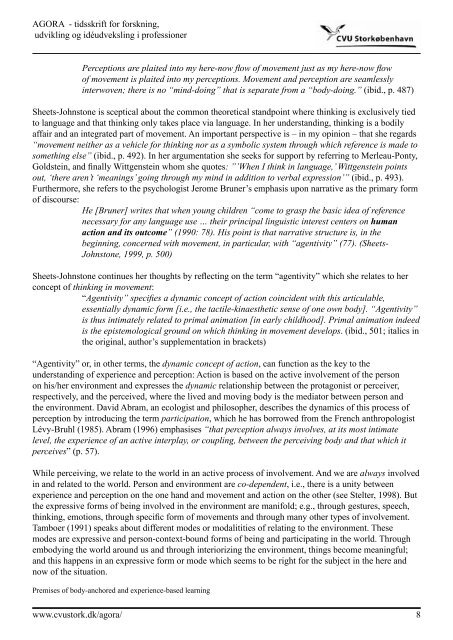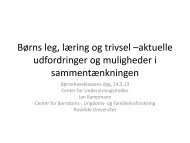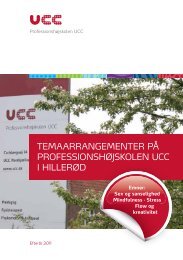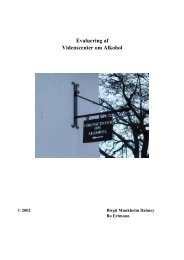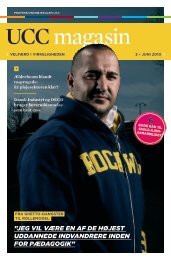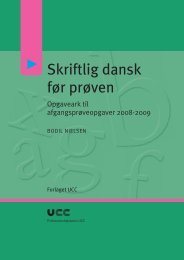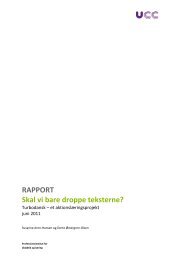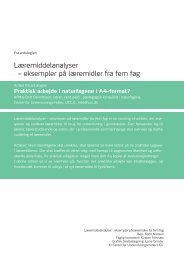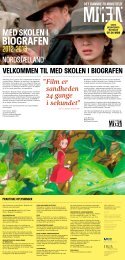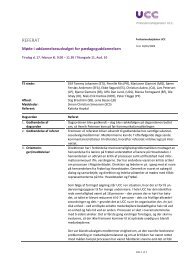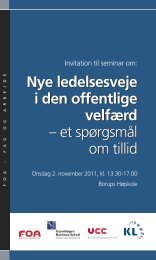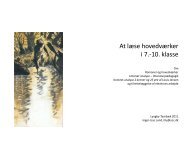AGORA - tidsskrift for forskning, udvikling og idéudveksling i ...
AGORA - tidsskrift for forskning, udvikling og idéudveksling i ...
AGORA - tidsskrift for forskning, udvikling og idéudveksling i ...
You also want an ePaper? Increase the reach of your titles
YUMPU automatically turns print PDFs into web optimized ePapers that Google loves.
<strong>AGORA</strong> - <strong>tidsskrift</strong> <strong>for</strong> <strong>for</strong>skning,<br />
<strong>udvikling</strong> <strong>og</strong> <strong>idéudveksling</strong> i professioner<br />
Perceptions are plaited into my here-now flow of movement just as my here-now flow<br />
of movement is plaited into my perceptions. Movement and perception are seamlessly<br />
interwoven; there is no “mind-doing” that is separate from a “body-doing.” (ibid., p. 487)<br />
Sheets-Johnstone is sceptical about the common theoretical standpoint where thinking is exclusively tied<br />
to language and that thinking only takes place via language. In her understanding, thinking is a bodily<br />
affair and an integrated part of movement. An important perspective is – in my opinion – that she regards<br />
“movement neither as a vehicle <strong>for</strong> thinking nor as a symbolic system through which reference is made to<br />
something else” (ibid., p. 492). In her argumentation she seeks <strong>for</strong> support by referring to Merleau-Ponty,<br />
Goldstein, and finally Wittgenstein whom she quotes: ”’When I think in language,’ Wittgenstein points<br />
out, ‘there aren’t ‘meanings’ going through my mind in addition to verbal expression’” (ibid., p. 493).<br />
Furthermore, she refers to the psychol<strong>og</strong>ist Jerome Bruner’s emphasis upon narrative as the primary <strong>for</strong>m<br />
of discourse:<br />
He [Bruner] writes that when young children “come to grasp the basic idea of reference<br />
necessary <strong>for</strong> any language use … their principal linguistic interest centers on human<br />
action and its outcome” (1990: 78). His point is that narrative structure is, in the<br />
beginning, concerned with movement, in particular, with “agentivity” (77). (Sheets-<br />
Johnstone, 1999, p. 500)<br />
Sheets-Johnstone continues her thoughts by reflecting on the term “agentivity” which she relates to her<br />
concept of thinking in movement:<br />
“Agentivity” specifies a dynamic concept of action coincident with this articulable,<br />
essentially dynamic <strong>for</strong>m [i.e., the tactile-kinaesthetic sense of one own body]. “Agentivity”<br />
is thus intimately related to primal animation [in early childhood]. Primal animation indeed<br />
is the epistemol<strong>og</strong>ical ground on which thinking in movement develops. (ibid., 501; italics in<br />
the original, author’s supplementation in brackets)<br />
“Agentivity” or, in other terms, the dynamic concept of action, can function as the key to the<br />
understanding of experience and perception: Action is based on the active involvement of the person<br />
on his/her environment and expresses the dynamic relationship between the protagonist or perceiver,<br />
respectively, and the perceived, where the lived and moving body is the mediator between person and<br />
the environment. David Abram, an ecol<strong>og</strong>ist and philosopher, describes the dynamics of this process of<br />
perception by introducing the term participation, which he has borrowed from the French anthropol<strong>og</strong>ist<br />
Lévy-Bruhl (1985). Abram (1996) emphasises “that perception always involves, at its most intimate<br />
level, the experience of an active interplay, or coupling, between the perceiving body and that which it<br />
perceives” (p. 57).<br />
While perceiving, we relate to the world in an active process of involvement. And we are always involved<br />
in and related to the world. Person and environment are co-dependent, i.e., there is a unity between<br />
experience and perception on the one hand and movement and action on the other (see Stelter, 1998). But<br />
the expressive <strong>for</strong>ms of being involved in the environment are manifold; e.g., through gestures, speech,<br />
thinking, emotions, through specific <strong>for</strong>m of movements and through many other types of involvement.<br />
Tamboer (1991) speaks about different modes or modalitities of relating to the environment. These<br />
modes are expressive and person-context-bound <strong>for</strong>ms of being and participating in the world. Through<br />
embodying the world around us and through interiorizing the environment, things become meaningful;<br />
and this happens in an expressive <strong>for</strong>m or mode which seems to be right <strong>for</strong> the subject in the here and<br />
now of the situation.<br />
Premises of body-anchored and experience-based learning<br />
www.cvustork.dk/agora/ 8


